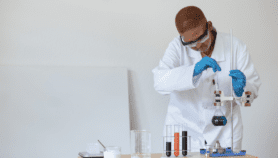Send to a friend
The details you provide on this page will not be used to send unsolicited email, and will not be sold to a 3rd party. See privacy policy.
Nanotechnology should not suffer the same fate as GM — potential health and environmental hazards should be monitored and regulated early on.
If a new and potentially hazardous field of technological innovation is to flourish in a social environment, two factors are essential, even if the hazards are still relatively speculative.
The first is a clear demonstration of its value to individual welfare, creating a demand for what it promises.
The second is evidence that the potential dangers can be adequately monitored, and regulations put in place to minimise the chance that harmful effects will occur.
In the case of genetically-modified crops, particularly those in Europe, the second of these has been achieved. But the benefits have been far from clear to consumers, with the main beneficiaries seen as US-based multinational corporations and seed companies, giving rise to heated opposition.
For some time, nanotechnology — the field of processes and products that operate at the nano-, or ultra-small, level — appeared to be facing a similar fate. Uncertainties over the potentially toxic effects of nanomaterials on both the human body and the natural environment have provided fertile ground for imaginative scare stories.
Unlike GM, however, the potential benefits to the individual have been relatively easy to describe. Nowhere is this truer than with applications of nanotechnology to modern medicine, ranging from more reliable diagnostic techniques to improved drug delivery systems.
Taking advantage of nanotech
This week, we publish a set of articles outlining how products and processes based on nanotechnology applications can help to improve the lives of those living in developing countries through a range healthcare innovations.
We also look at what these countries need to do to ensure they are in a position to take advantage of the benefits that nanotechnology offers in the field of healthcare — as well as to avoid any undesirable effects.
An overview article by Priya Shetty, who helped us to select the issues that we needed to cover, provides a synopsis of the main contributions that nanotechnology can make in this field.
These range from novel forms of diagnosis — for example using probes that can investigate biological malfunctioning down to the molecular level — to techniques for delivering drugs exactly where they are needed in the human body, increasing their effectiveness and significantly reducing wastage through over-dosage.
In an accompanying feature article, Munyaradzi Makoni, a freelance science journalist in South Africa, describes how that country is playing a leading role in developing such procedures in ways that are directly relevant to the needs of developing countries.
In particular, South African researchers have been working on new forms of diagnosis and treatment for tuberculosis (TB), which remains a major killer on the African continent.
For example, they hope a new generation of slow-released anti-TB drugs will overcome the difficulties of ensuring effective compliance by patients of existing drugs that require a strict daily regime to be followed. Similar work on TB diagnostics is also being done in India.
Nanohealth and developing countries
A series of opinion articles from nanotechnology experts highlight some of the broader issues that need to be addressed if the full potential of this new technology are to be harnessed to the task of improving human health.
Donald Maclurcan at the Institute for Nanoscale Technology at the University of Technology, Sydney, suggests that if nanotechnology is to contribute to the Millennium Development Goals, particularly those relating to health, the role of developing countries in nanohealth innovation should not be ignored. Mohamed Abdel-Mottaleb, director of the centre for nanotechnology at the Nile University in Cairo, Egypt, argues that nanotechnology offers significant potential to tackle systemic health-related problems in developing countries, and needs to be effectively integrated into their health planning.
Guillermo Foladori, professor of development studies at the Universidad Autónoma de Zacatacas, Mexico, puts the case for an even broader approach, showing how nanotechnology for health should not only focus on treating disease, but also on improving living conditions.
Rajender Varma an expert in sustainable technologies with the US Environmental Protection Agency — but writing in a personal capacity — says that some of the potential hazards associated with conventional ways of producing nanotechnology products could be avoided by adopting a more environmentally-friendly approach. He describes how this approach is being developed in India.
Finally Manoj Varma of the Centre for Nano Science and Engineering at the Indian Institute of Science, Bangalore, argues that in a developing country like India, it is still too early for industry to rush into commercialising ‘killer apps’ based on nanotechnology.
Finally, these articles are complemented by a set of links to key documents and background material on the potential contributions of nanotechnology to health, by information on and links to organisations concerned with this issue, and by a list of definitions intended to help the non-expert to find his/her way around this challenging new field.
Vigilance is important
Of course, as several of these articles emphasize, excitement about the promise that nanotechnology offers to improving health-care should not blind either policymakers or the public to the potential hazards that could, at least in theory, be linked with the novel products and processes involved.
As with any new technology, some of the dangers may be easy to watch out for (such as interactions with biological material at the cellular level). Others could be unexpected, providing scope for the type of horror scenarios — such as rampant plastic-destroying molecules — that have led to calls for a moratorium on nanotechnology in general.
Developing countries, like their developed counterparts, must be vigilant. This means that they need to build both regulatory frameworks, and cadres of trained individuals to ensure they are complied with. These must be adequate to ensure the technology develops safely, and the risk of human or environmental damage is kept to a minimum (even if it can never be entirely eliminated).
But there is no reason to believe that, given sufficient political commitment (including the required financial resources), this cannot be achieved. Or that, if appropriately monitored, nanotechnology cannot produce a revolution in healthcare that will contribute substantially to improving the lives of individuals across the developing world.
David Dickson
Director, SciDev.Net
This article is part of a spotlight on Nanotechnology for health.













